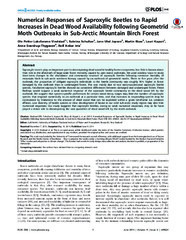Numerical responses of saproxylic beetles to rapid increases in dead wood availability following geometrid moth outbreaks in sub-arctic mountain birch forest
Permanent lenke
https://hdl.handle.net/10037/7338Dato
2014Type
Journal articleTidsskriftartikkel
Peer reviewed
Forfatter
Laksforsmo Vindstad, Ole Petter; Schultze, Sabrina; Jepsen, Jane Uhd; Biuw, Erik Martin; Kapari, Lauri Teemu; Sverdrup-Thygeson, Anne; Ims, Rolf AnkerSammendrag
Saproxylic insects play an important part in decomposing dead wood in healthy forest ecosystems, but little is known about their role in the aftermath of large-scale forest mortality caused by pest insect outbreaks. We used window traps to study short-term changes in the abundance and community structure of saproxylic beetles following extensive mortality of mountain birch in sub-arctic northern Norway caused by an outbreak of geometrid moths. Three to five years after the outbreak, the proportion of obligate saproxylic individuals in the beetle community was roughly 10% higher in forest damaged by the outbreak than in undamaged forest. This was mainly due to two early-successional saproxylic beetle species. Facultative saproxylic beetles showed no consistent differences between damaged and undamaged forest. These findings would suggest a weak numerical response of the saproxylic beetle community to the dead wood left by the outbreak. We suggest that species-specific preferences for certain wood decay stages may limit the number of saproxylic species that respond numerically to an outbreak at a particular time, and that increases in responding species may be constrained by limitations to the amount of dead wood that can be exploited within a given timeframe (i.e. satiation effects). Low diversity of beetle species or slow development of larvae in our cold sub-arctic study region may also limit numerical responses. Our study suggests that saproxylic beetles, owing to weak numerical responses, may so far have played a minor role in decomposing the vast quantities of dead wood left by the moth outbreak.
Forlag
Public Library of Science (PLoS)Sitering
PLoS ONE (2014) Volume 9, Issue 6, e99624Metadata
Vis full innførselSamlinger
Følgende lisensfil er knyttet til denne innførselen:


 English
English norsk
norsk